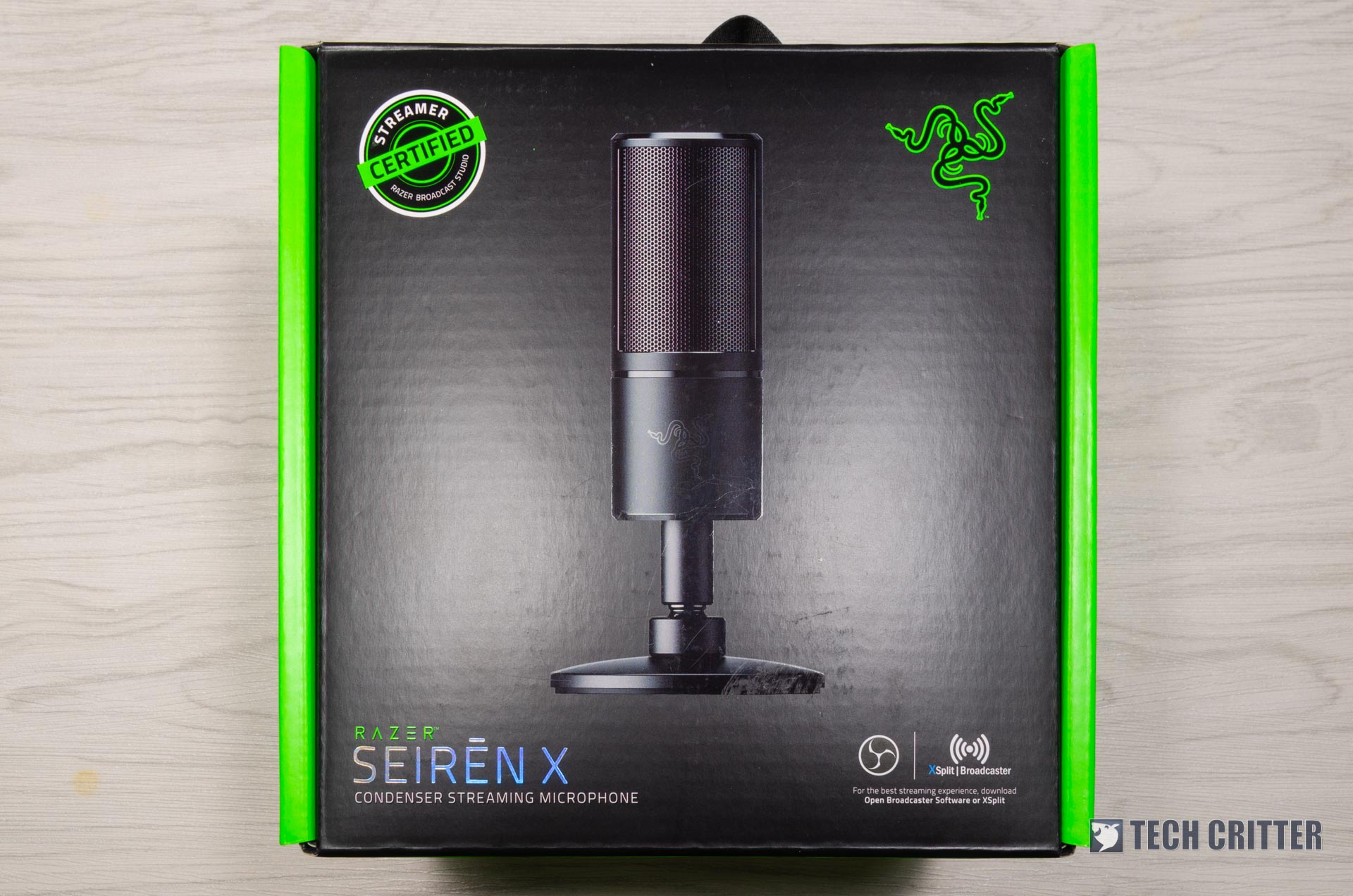Razer released the Seiren, its first professional-grade microphone back in the year 2015 as its expansion to a different category which they never explored before. While it does look pretty promising from the way it is marketed, the price, however, isn’t that enticing to the mass. Although we didn’t get to play with the Seiren, we did manage to get our hand on the latest addition to the lineup, the Seiren X. The Seiren X is a more portable version of its predecessor, as well as being more specified in terms of the function instead of being a do-everything microphone.
Specifications
| Microphone
|
|
| Headphone amplifier
|
|
| System requirements
|
|
| Package contents
|
|
Unboxing

Packaging wise, the size of the box is notably smaller compared to the Seiren. Apart from its seemingly more portable and simple design, Razer marketed it as a condenser microphone that is specifically made for game streaming.

Not many details can be found at the back of the box though, except for the briefly described features of the Seiren X i.e compact form factor, ultra-precise pickup pattern and its shock resistant design.
First thing you’ll see upon unboxing is the Razer Seiren X, which a cool sleek and simple design. Unlike its predecessor, the Razer Seiren X is just as small as a soda can that probably won’t take up too much space on your desk.
Removing the top compartment reveals the usual love letter from the CEO himself, for getting yourself a Razer-branded product. The accessories can be found at the bottom compartment, which consists of the base of the microphone and the USB cable.

Here’s a better look of all the parts of the Razer Seiren X – the USB cable, the main body or the microphone, the cylinder and base for the microphone stand. From all these parts, you can really see how easy it is to set up the Razer Seiren X, compared to the Razer Seiren which requires more effort to set up.
The Razer Seiren X

Form factor wise, the Razer Seiren X is just as mentioned earlier, as small as a soda can. Apart from being small, the microphone looks pretty good if you ask me. Its simple and sleek design gave it a cool and classy appearance, which is much to our personal taste.

Of course, a Razer product wouldn’t be a Razer product if it doesn’t come with that iconic three-headed snake logo on it.

The volume control knob and mute button.

At the bottom of the microphone, you’ll find the micro USB port for the USB cable and the 3.5mm audio jack for live monitoring.
This slideshow requires JavaScript.
The ball joint on the base allows you to position the Razer Seiren X at your preferred angle. Now here’s the interesting part of the Razer Seiren X. The base is surprisingly heavy, so heavy that it’s able to keep the microphone balance without toppling over from a push with a significant amount of force.

The heavy metal base with vibration dampening foam – the key component that keeps the microphone stable and preventing any unnecessary noise caused by the external source of vibration.
User Experience
For the user experience, we’ve actually done a live unboxing and test during one of our live stream session on Dinotalk hosted by Rextech – you watch the video here. Compared to the Gaming Freak Chanter microphone which is used in most of the previous live stream session, here are the differences we can tell between both the Chanter and Razer Seiren X:
- Smaller footprint – The Razer Seiren X has a significantly smaller footprint than the Gaming Freak Chanter, which makes it ideal for streamers who has smaller desk space for equipment
- Better stability – Thanks to the heavier base, the Razer Seiren X doesn’t topple easily regardless of the direction which it is inclined to.
- Voice is noticeably deeper – It can be a good thing for male streamers, as we did notice that our voice sounds slightly deeper (manlier?) during our live test.
- Better noise cancellation – Unlike the Chanter, surrounding noise from random knocking, keyboard typing, vibration on the desk is barely noticeable when we’re using the Razer Seiren X. No additional attachment like a pop filter or any form of cover is required.
Then again, it’s not the best around as we’ve actually tried other alternatives at the similar price point, but sounded way better than the Razer Seiren X. This doesn’t mean that the Razer Seiren X is bad and not really worth the money, of course. From the design and features it has, we’d say that the Razer Seiren X is more of an option for streamers that just want a microphone that is easy to configure and offers features which they really need for the streaming purposes. For music streamers, it can also be used for your music streams while playing an instrument, which in our case, we tested the microphone while playing a Yamaha guitar.
Final Thoughts
At the price of RM 425, we believe many of you would have thought of other alternatives at a similar price point or less, that is able to perform a few times better than the Razer Seiren X. But then again, some of those alternatives might require some additional effort in tweaking the sound quality, or even equipment to improve the usability of the microphone itself – something that is not really starters friendly.
The Razer Seiren X offers pretty much most of the basic needs that most streamers need, such as easy to install and configure, reasonable noise cancellation. After all, Razer did market it as a streaming microphone – easy to use for the starters, not a multi-purpose microphone.
Pros
- Easy to set up, no additional configuration required
- Small footprint, compact design
- Simple, sleek and stylish design
- Surprisingly stable design
- Reasonable noise cancellation
Cons
- USB only output
- No additional accessories provided













